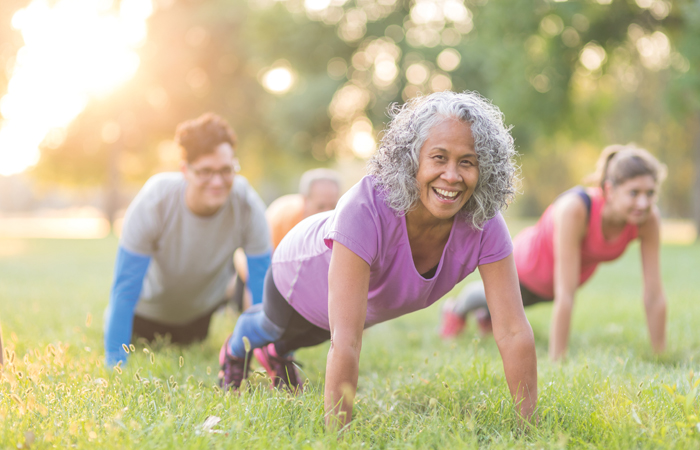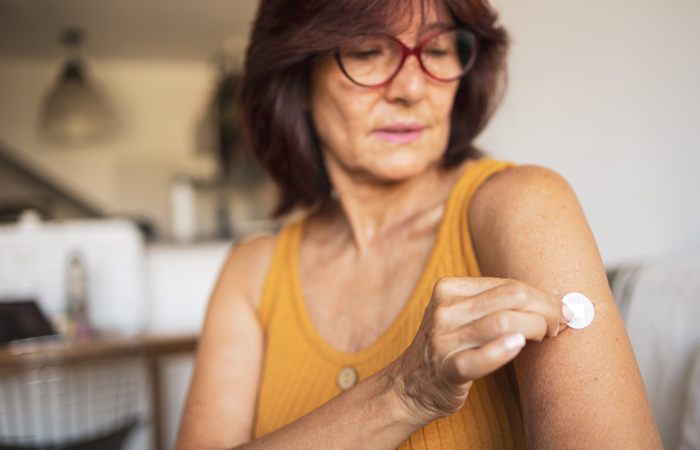In OTC
Follow this topic
Bookmark
Record learning outcomes
In recent years well-known women such as Davina McCall and Lisa Snowdon have shone a much-needed light on menopause and hormone replacement therapy (HRT), talking frankly about their experiences and bringing the conversation about this life-stage out in the open.
Pharma companies, too, are recognising the importance of supporting women through menopause – Astellas Pharma’s Veozah (fezolinetant) treatment for moderate to severe hot flushes and night sweats has become the first nonhormonal neurokinin 3 (NK3) receptor antagonist approved by the US Food and Drug Administration (FDA) to treat vasomotor symptoms (VMS) due to menopause and is in the process of being assessed by the European Medicines Agency.
All of this is good news for the estimated 13 million people who are currently perimenopausal or menopausal in the UK, since the menopause can cause a wide range of physical and psychological symptoms that can last for several years.
What is perimenopause?
Perimenopause and menopause are a natural part of a woman’s life and usually occur between the ages of 45-55 years, as oestrogen levels drop. Perimenopause is the time from the start of menopausal symptoms where periods become less frequent, irregular, heavier or lighter over a few months or years before they stop altogether.
Reasons for early menopause
The average age of the menopause in Europe is 51 but, according to Dr Diana Mansour, consultant in community gynaecology and reproductive healthcare in Newcastle upon Tyne and expert contributor to The Menopause Exchange, five per cent of women experience an early menopause (aged 40-45) and in one per cent of women the menopause occurs before the age of 40.
If a woman’s ovaries stop making normal levels of certain hormones, particularly the hormone oestrogen, this is sometimes called premature ovarian failure, or primary ovarian insufficiency. The cause is often unknown, but in some women, it may be caused by chromosome abnormalities – such as in women with Turner syndrome (an autoimmune disease), genetics and certain infections such as tuberculosis, malaria and mumps – but this is very rare.
Radiotherapy and chemotherapy can also cause premature ovarian failure, which may be temporary or permanent, and any surgery that removes both ovaries will also bring on early menopause.
Menopause symptoms
“In most women, menopausal symptoms last for around seven years but sometimes these can last much longer,” says Norma Goldman, pharmacist and founder and director of The Menopause Exchange.
Indeed, it is estimated that around 20 per cent of women may experience symptoms for 15 years or more, while a lucky 20 per cent have no problems at all.
Common symptoms include:
Hot flushes and night sweats: 70-80 per cent of women complain of flushes and sweats (vasomotor symptoms), thought to be caused by fluctuating and finally decreasing levels of oestrogen affecting the body’s thermostat in the brain’s hypothalamus.
“Hot flushes and sweats seem to be worse in women who smoke, are overweight, drink large amounts of alcohol, have underlying mental health issues or who have gone through a rapid transition, such as having a medical or surgical menopause caused by chemo/drug therapy or the removal of both ovaries,” says Dr Mansour. “Vasomotor symptoms reach their peak about 18 months after a woman’s last natural period and tend to decrease with time.”
Vaginal and bladder symptoms: As women approach menopause, one in four have vaginal dryness. After the menopause, 50 per cent of women suffer from urogenital symptoms, such as vaginal dryness, irritation, burning, pain with sex, urinary frequency/urgency and recurrent urinary tract infections.
“These are caused by low levels of oestrogen, resulting in a loss of fat around the genitals and the vaginal tissue becoming paler, thinner and less well lubricated,” says Dr Mansour. “The changes also affect the urethra and bladder, taking months or sometimes years to trigger symptoms.”
Aches and pains: Many menopausal women experience ‘menopausal arthralgia’, with joint pain, muscle aches and back pain affecting more than 50 per cent of women. “These symptoms can be due to hormonal changes but may be exacerbated by dehydration, stress, weight gain, diet and poor posture,” explains Dr Mansour.
Brain and mood: “Menopausal women may notice increasing anxiety and mood changes, such as irritability, sadness, lack of motivation, aggressiveness and difficulty concentrating,” says Dr Mansour. “They get more forgetful, experience brain fog and find it hard to stay focused. Women may experience wordfinding difficulties, lose their train of thought and get confused easily. These symptoms improve with time but can last for up to 10 years.”
Sleep problems: Changes in oestrogen and progesterone levels directly affect the sleep cycle, up to 60 per cent of menopausal women experience insomnia or other sleep problems. “Many have no difficulty getting to sleep but staying asleep is the issue and early morning wakening increases significantly,” adds Dr Mansour. “This can have detrimental effects on the risk of cardiovascular disease, diabetes, dementia and obesity and may even reduce the body’s immunity and cancer-fighting ability.”
Lifestyle changes: Pharmacy teams can offer a wealth of advice on lifestyle changes to help ease these symptoms. “Self care is so important and can make a huge difference to symptoms,” says Alison Cullen, A.Vogel education manager and menopause specialist, who recommends prioritising diet, exercise and sleep at this time. “Maintaining a healthy diet is crucial with a focus on nutrient-rich foods like fruits, vegetables, whole grains, and lean proteins,” says Alison. “It’s also essential to stay hydrated and limit caffeine and alcohol intake, as these stimulants can trigger hot flashes, disrupt sleep patterns and add to dehydration.”
Regular exercise is highly beneficial during menopause as it releases endorphins, which are natural mood boosters, and can alleviate symptoms of depression and anxiety commonly experienced during menopause, as well as easing other symptoms like hot flushes and joint pain.
Getting enough sleep is also crucial, as hormonal changes can disrupt sleep patterns and vice versa. Alison recommends creating a relaxing bedtime routine, such as reading a book or practising meditation, and limiting screen time an hour or two before bed, to promote better sleep quality.

Regular exercise is highly beneficial during menopause as it releases endorphins, which are natural mood boosters.
Looking after the skin
Many women may also not realise that high exposure to UV radiation is associated with an adverse hormone balance post menopause and could negatively affect healthy ageing. “A large population study published in March 2021 showed that UV radiation is particularly damaging after menopause because it reduces levels of some oestrogens – estradiol and estrone – while increasing levels of follicle-stimulating hormone and luteinizing hormone, a combination associated with osteoporosis,” says GP Dr Hilary Jones. “Managing ultraviolet radiation (UVR) exposure has the potential to influence the hormone balance and counteract adverse health conditions after menopause.”
Women’s health and skincare specialist – and advisor to Hada Labo Tokyo premium skincare range – Dr Catherine Hood adds that diet is vital in helping to maintain healthy skin during perimenopause and beyond. “Look to include colourful fruits and vegetables, alongside lean proteins such as chicken, turkey and fish, and whole grain carbs such as brown rice and quinoa,” she advises. “Stay hydrated throughout the day with water and herbal teas. Alcohol and caffeine can contribute to skin dryness, so try to limit these when you can.”
Exploring treatment options
The National Institute for Health and Care Excellence (NICE) guidelines suggest hormone replacement therapy (HRT) is the best way to help with symptom control.
HRT involves supplementing oestrogen and/or progesterone and is available as tablets, patches or gels. The patches are usually changed twice a week, the gel is applied to the skin daily, and tablets are usually taken daily.
“Women who are perimenopausal will be prescribed daily oestrogen with cyclical progestogen as this more closely mimics the endogenous hormone cycle,” says Jacquie Lee, Numark medication safety officer and information pharmacist. “Whereas postmenopausal women will have a continuous combined regimen where oestrogen and progestogen are taken daily, and women who have had a hysterectomy will only require oestrogen therapy.”
Side effects from HRT can be triggered by oestrogen and progestogen and will be most noticeable in the first three months of treatment. “Oestrogenic side effects can include breast tenderness or enlargement, leg cramps, bloating, nausea and headache,” says Jacquie. “Whereas progestogenic side effects include PMS type symptoms, breast tenderness, lower abdominal pain, backache, acne or greasy skin, headache and depressed mood.”
Research also shows that cognitive behavioural therapy (CBT) or talking therapies can help some women, but for women who don’t want either that or HRT, the NICE guidelines suggest some prescribed non-hormonal treatments for menopausal hot flushes and night sweats which can help.
“Clonidine, an older drug, is the only non-hormonal drug licensed for menopausal flushing,” explains Jacquie. “It needs to be prescribed at quite high doses to have an effect on hot flushes and can cause side effects, such as sleep disturbances and a dry mouth.
“Selective Serotonin Reuptake Inhibitor (SSRI) antidepressants are also sometimes prescribed as an alternative to HRT, with paroxetine, fluoxetine and citalopram shown to help with hot flushes and night sweats.”
There are also non-hormonal OTC products that can help with some of the symptoms such as products for insomnia; products to help vaginal and bladder problems (vaginal moisturisers and lubricants); products to help memory loss and brain fog, mood swings and emotional symptoms, such as anxiety, depression, and panic disorder; and those for dry mouth and eyes.

Further resources:
- Anyone with an interest in the menopause, midlife and post-menopausal health can receive The Menopause Exchange quarterly newsletter for free
- A.Vogel Menopause Huub
- Women’s Health Concern menopause advice hub offers evidence-based, peer reviewed information to women and their partners.

